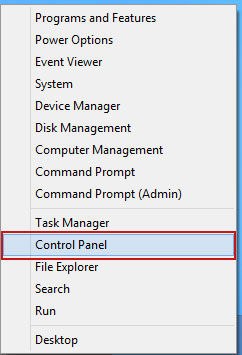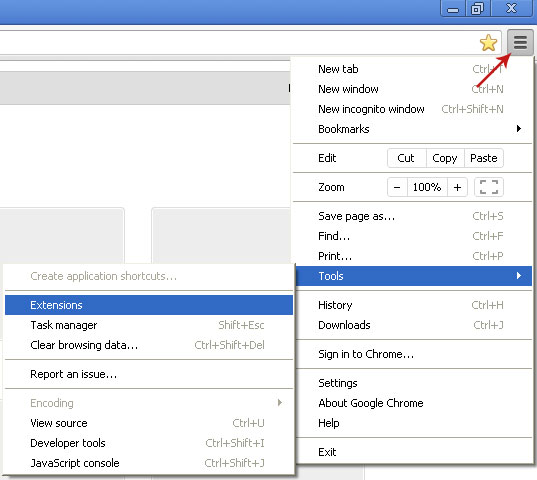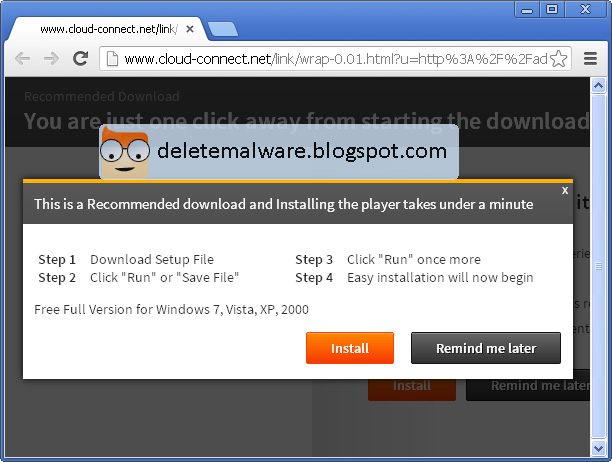What this then means is that virus which causes cloud-connect.net popups to show up will redirect you to a web page that you may have no interest in visiting. These websites are usually stuffed full of adverts, are gambling sites, weight loss sites or fake flash player update websites. Maybe you don’t actually mind visiting these sites but chances are you were trying to reach a completely different online destination in the first place before you got redirected so it can still be annoying. You will probably also find that you are bombarded with a never ending rotation of pop-up adverts.
To remove cloud-connect.net virus from your computer you will have to uninstall recently installed applications and scan your computer with recommend anti-malware software. Pop-up blockers rarely help in such cases. Re-installing your web browser probably won't help you either. Anti-malware applications should be able to identify the browser hijacker and will then either scan your infected files and make them immune to further hijacking or they will allow you see all of the programs that are on your system the next time you log on so that you can choose which ones you allow to run.
If you’ve run the scan and rebooted your system and you’ve still not managed to get rid of the cloud-connect.net virus, then you have picked up a very nasty strain of hijacking and you will probably need to seek professional help as the browser hijacker will very likely have been installed onto your PC via another application that was installed without your knowledge or permission. In these cases the malicious software is notoriously difficult to even find on your computer as it will have been hidden deep in the depths of your system making it virtually impossible for a regular PC user to find and delete.
And if you don’t have anti-malware software installed on your PC – as soon as you’ve got the problem sorted out that should be the very next thing that you do before you become the victim of a browser hijacking for the second time!
If you have any questions or need help removing this malware from your computer, please leave a comment below. Just make sure you did everything correctly as explained in the removal guide below. Good luck and be safe online!
Written by Michael Kaur, http://deletemalware.blogspot.com
Cloud-connect.net virus removal instructions:
1. First of all, download recommended anti-malware software and run a full system scan. It will detect and remove this infection from your computer. You may then follow the manual removal instructions below to remove the leftover traces of this browser hijacker. Hopefully you won't have to do that.
2. Uninstall recently installed applications including web browser extensions and related programs from your computer using the Add/Remove Programs control panel (Windows XP) or Uninstall a program control panel (Windows 7 and Windows 8).
Go to the Start Menu. Select Control Panel → Add/Remove Programs.
If you are using Windows Vista or Windows 7, select Control Panel → Uninstall a Program.

If you are using Windows 8, simply drag your mouse pointer to the right edge of the screen, select Search from the list and search for "control panel".

Or you can right-click on a bottom left hot corner (formerly known as the Start button) and select Control panel from there.

3. When the Add/Remove Programs or the Uninstall a Program screen is displayed, scroll through the list of currently installed programs and remove Auto-Lyrics, DownloadTerms, LyricsPal, FindLyrics, LyricsContainer and any other recently installed application.

Simply select the application and click Remove. If you are using Windows Vista, Windows 7 or Windows 8, click Uninstall up near the top of that window. When you're done, please close the Control Panel screen.
Remove cloud-connect.net from Google Chrome:
1. Click on Chrome menu button. Go to Tools → Extensions.

2. Click on the trashcan icon to remove Auto-Lyrics, DownloadTerms, LyricsPal, FindLyrics, LyricsContainer or any other recently installed extension.

Remove cloud-connect.net from Mozilla Firefox:
1. Open Mozilla Firefox. Go to Tools → Add-ons.

2. Select Extensions. Remove Auto-Lyrics, DownloadTerms, LyricsPal, FindLyrics, LyricsContainer or any other recently installed extension. Close the window.

Remove cloud-connect.net from Internet Explorer:
1. Open Internet Explorer. Go to Tools → Manage Add-ons.

2. Select Toolbars and Extensions. Remove Auto-Lyrics, DownloadTerms, LyricsPal, FindLyrics, LyricsContainer Internet Explorer add-ons.

















0 comments:
Post a Comment